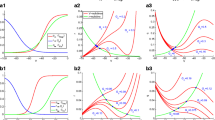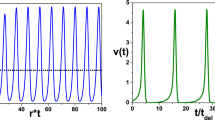Abstract
The Hodgkin-Huxley (HH) model is the basis for numerous neural models. There are two negative feedback processes in the HH model that regulate rhythmic spiking. The first is an outward current with an activation variable n that has an opposite influence to the excitatory inward current and therefore provides subtractive negative feedback. The other is the inactivation of an inward current with an inactivation variable h that reduces the amount of positive feedback and therefore provides divisive feedback. Rhythmic spiking can be obtained with either negative feedback process, so we ask what is gained by having two feedback processes. We also ask how the different negative feedback processes contribute to spiking. We show that having two negative feedback processes makes the HH model more robust to changes in applied currents and conductance densities than models that possess only one negative feedback variable. We also show that the contributions made by the subtractive and divisive feedback variables are not static, but depend on time scales and conductance values. In particular, they contribute differently to the dynamics in Type I versus Type II neurons.













Similar content being viewed by others
References
Clewley, R. (2004). Dominant scale analysis for automatic reduction of high-dimensional ODE systems. In Bar-Yam Y (Ed.), ICCS 2004 Proceedings. New England: Complex Systems Institute.
Clewley, R. (2011). Inferring and quantifying the role of an intrinsic current in a mechanism for a half-center bursting oscillation: a dominant scale and hybrid dynamical systems analysis. Journal of Biological Physics. doi:10.1007/s10867-011-9220-1.
Clewley, R. (2012). Hybrid models and biological model reduction with PyDSTool. PLoS Computational Biology, 8(8), e1002628.
Clewley, R., Rotstein, H. G., & Kopell, N. (2005). A computational tool for the reduction of nonlinear ODE systems possessing multiple scales. Multiscale Modeling and Simulation, 4(3), 732–759.
Clewley, R., Soto-Treviño, C., & Nadim, F. (2009). Dominant ionic mechanisms explored in the transition between spiking and bursting using local low-dimensional reductions of a biophysically realistic model neuron. Journal of Computational Neuroscience, 26(1), 75–90.
Ermentrout, G. (1996). Type I membranes, phase resetting curves, and synchrony. Neural Computation, 7(5), 979–1001.
Ermentrout, G. (2002). Simulating, analyzing, and animating dynamical systems. Philadelphia, PA: SIAM.
Ermentrout, G., & Chow, C. C. (2002). Modeling neural oscillations. Physiology & Behaviour, 77(2002), 629–633.
Fitzhugh, R. (1960). Thresholds and plateaus in the Hodgkin-Huxley nerve equations. The Journal of General Physiology, 43(5), 867–896.
Fitzhugh, R. (1961). Impulses and physiological states in theoretical models of nerve membrane. Biophysical Journal, 1(6), 445–466.
Friesen, W. O., & Block, G. D. (1984). What is a biological oscillator? The American Journal of Physiology, 246(6 Pt 2), R847–R853.
Hairer, E., & Wanner, G. (1999). Stiff differential equations solved by Radau methods. Journal of Computational and Applied Mathematics, 111, 93–111.
Hodgkin, A. L. (1948). The local electric changes associated with repetitive action in a non-medullated axon. Journal of Physiology, 107(2), 165–181.
Hodgkin, A. L., & Huxley, A. F. (1952). A quantitative description of membrane current and its application to conduction and excitation in nerve. Journal of Physiology, 117(4), 500–544.
Howell, A. S., Jin, M., Wu, C., Zyla, T. R., Elston, T. C., & Lew, D. J. (2012). Negative feedback enhances robustness in the yeast polarity establishment circuit. Cell, 149(2), 322–333.
Izhikevich, E. M. (1999). Class 1 neural excitability, conventional synapses, weakly connected networks, and mathematical foundations of pulse-coupled models. IEEE Transaction on Neural Networks, 10(3), 499–507.
Izhikevich, E. M. (2000). Neural excitability, spiking, and bursting. International Journal of Bifurcation and Chaos, 10(6), 1171–1266.
Kopell, N., Ermentrout, G. B., Whittington, M. A., & Traub, R. D. (2000). Gamma rhythms and beta rhythms have different synchronization properties. Proceedings of the National Academy of Sciences of the United States of America, 97(4), 1867–1872.
Meng, X., Huguet, G., & Rinzel, J. (2012). Type III excitability, slope sensitivity and coincidence detection. Discrete and Continuous DYnamical Systems, 32(8), 2729–2757.
Morris, C., & Lecar, H. (1981). Voltage oscillations in the barnacle giant muscle fiber. Biophysical Journal, 35(1), 193–213.
Nagumo, J., Arimoto, S., & Yoshizawa, S. (1962). An active pulse transmission line simulating nerve axon. Proceedings of the IRE, 50(10), 2061–2070.
Rinzel, J. (1985). Excitation dynamics: insights from simplified membrane models. Federation Proceedings, 4(15), 2944–2946.
Tabak, J., O’Donovan, M. J., & Rinzel, J. (2006). Differential control of active and silent phases in relaxation models of neuronal rhythms. Journal of Computational Neuroscience, 21(3), 307–328.
Tabak, J., Rinzel, J., & Bertram, R. (2011). Quantifying the relative contributions of divisive and subtractive feedback to rhythm generation. PLoS Computational Biology, 7(4), e1001124.
Tomaiuolo, M., Bertram, R., & Houle, D. (2008). Enzyme isoforms may increase phenotypic robustness. Evolution, 62(11), 2884–2893.
Tsai, T. Y., Choi, Y. S., Ma, W., Pomerening, J. R., Tang, C., & Ferrell, J. E., Jr. (2008). Robust, tunable biological oscillations from interlinked positive and negative feedback loops. Science, 321(5885), 126–129.
Wang, X.J., & Rinzel, J. (1992). Alternating and synchronous rhythms in reciprocally inhibitory model neurons. Neural Computation, 4(1), 84–97.
Acknowledgments
RB and JT were supported by NIH grant DK43200 and NSF grant DMS1220063.
Conflict of interest
The authors declare that they have no conflict of interest.
Author information
Authors and Affiliations
Corresponding author
Additional information
Action Editor: J. Rinzel
Electronic supplementary material
Below is the link to the electronic supplementary material.
ESM 1
(RTF 0 kb)
Rights and permissions
About this article
Cite this article
Şengül, S., Clewley, R., Bertram, R. et al. Determining the contributions of divisive and subtractive feedback in the Hodgkin-Huxley model. J Comput Neurosci 37, 403–415 (2014). https://doi.org/10.1007/s10827-014-0511-y
Received:
Revised:
Accepted:
Published:
Issue Date:
DOI: https://doi.org/10.1007/s10827-014-0511-y




